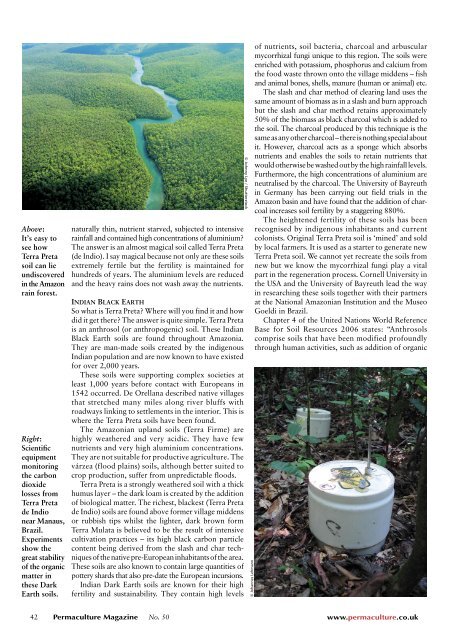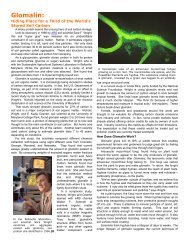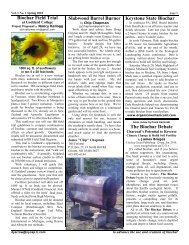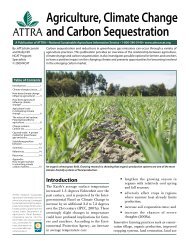Carmichael-Timson
Article on Terra Preta (.pdf) - Department of Crop and Soil Sciences
Article on Terra Preta (.pdf) - Department of Crop and Soil Sciences
- No tags were found...
You also want an ePaper? Increase the reach of your titles
YUMPU automatically turns print PDFs into web optimized ePapers that Google loves.
Above:<br />
It’s easy to<br />
see how<br />
Terra Preta<br />
soil can lie<br />
undiscovered<br />
in the Amazon<br />
rain forest.<br />
Right:<br />
Scientific<br />
equipment<br />
monitoring<br />
the carbon<br />
dioxide<br />
losses from<br />
Terra Preta<br />
de Indio<br />
near Manaus,<br />
Brazil.<br />
Experiments<br />
show the<br />
great stability<br />
of the organic<br />
matter in<br />
these Dark<br />
Earth soils.<br />
naturally thin, nutrient starved, subjected to intensive<br />
rainfall and contained high concentrations of aluminium?<br />
The answer is an almost magical soil called Terra Preta<br />
(de Indio). I say magical because not only are these soils<br />
extremely fertile but the fertility is maintained for<br />
hundreds of years. The aluminium levels are reduced<br />
and the heavy rains does not wash away the nutrients.<br />
INDIAN BLACK EARTH<br />
So what is Terra Preta? Where will you find it and how<br />
did it get there? The answer is quite simple. Terra Preta<br />
is an anthrosol (or anthropogenic) soil. These Indian<br />
Black Earth soils are found throughout Amazonia.<br />
They are man-made soils created by the indigenous<br />
Indian population and are now known to have existed<br />
for over 2,000 years.<br />
These soils were supporting complex societies at<br />
least 1,000 years before contact with Europeans in<br />
1542 occurred. De Orellana described native villages<br />
that stretched many miles along river bluffs with<br />
roadways linking to settlements in the interior. This is<br />
where the Terra Preta soils have been found.<br />
The Amazonian upland soils (Terra Firme) are<br />
highly weathered and very acidic. They have few<br />
nutrients and very high aluminium concentrations.<br />
They are not suitable for productive agriculture. The<br />
várzea (flood plains) soils, although better suited to<br />
crop production, suffer from unpredictable floods.<br />
Terra Preta is a strongly weathered soil with a thick<br />
humus layer – the dark loam is created by the addition<br />
of biological matter. The richest, blackest (Terra Preta<br />
de Indio) soils are found above former village middens<br />
or rubbish tips whilst the lighter, dark brown form<br />
Terra Mulata is believed to be the result of intensive<br />
cultivation practices – its high black carbon particle<br />
content being derived from the slash and char techniques<br />
of the native pre-European inhabitants of the area.<br />
These soils are also known to contain large quantities of<br />
pottery shards that also pre-date the European incursions.<br />
Indian Dark Earth soils are known for their high<br />
fertility and sustainability. They contain high levels<br />
© Johnny Lye / Shutterstock<br />
© Johannes Lehmann<br />
of nutrients, soil bacteria, charcoal and arbuscular<br />
mycorrhizal fungi unique to this region. The soils were<br />
enriched with potassium, phosphorus and calcium from<br />
the food waste thrown onto the village middens – fish<br />
and animal bones, shells, manure (human or animal) etc.<br />
The slash and char method of clearing land uses the<br />
same amount of biomass as in a slash and burn approach<br />
but the slash and char method retains approximately<br />
50% of the biomass as black charcoal which is added to<br />
the soil. The charcoal produced by this technique is the<br />
same as any other charcoal – there is nothing special about<br />
it. However, charcoal acts as a sponge which absorbs<br />
nutrients and enables the soils to retain nutrients that<br />
would otherwise be washed out by the high rainfall levels.<br />
Furthermore, the high concentrations of aluminium are<br />
neutralised by the charcoal. The University of Bayreuth<br />
in Germany has been carrying out field trials in the<br />
Amazon basin and have found that the addition of charcoal<br />
increases soil fertility by a staggering 880%.<br />
The heightened fertility of these soils has been<br />
recognised by indigenous inhabitants and current<br />
colonists. Original Terra Preta soil is ‘mined’ and sold<br />
by local farmers. It is used as a starter to generate new<br />
Terra Preta soil. We cannot yet recreate the soils from<br />
new but we know the mycorrhizal fungi play a vital<br />
part in the regeneration process. Cornell University in<br />
the USA and the University of Bayreuth lead the way<br />
in researching these soils together with their partners<br />
at the National Amazonian Institution and the Museo<br />
Goeldi in Brazil.<br />
Chapter 4 of the United Nations World Reference<br />
Base for Soil Resources 2006 states: “Anthrosols<br />
comprise soils that have been modified profoundly<br />
through human activities, such as addition of organic<br />
42 Permaculture Magazine No. 50 www.permaculture.co.uk





